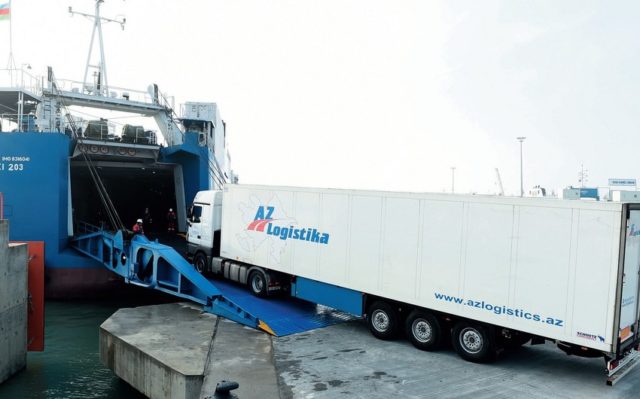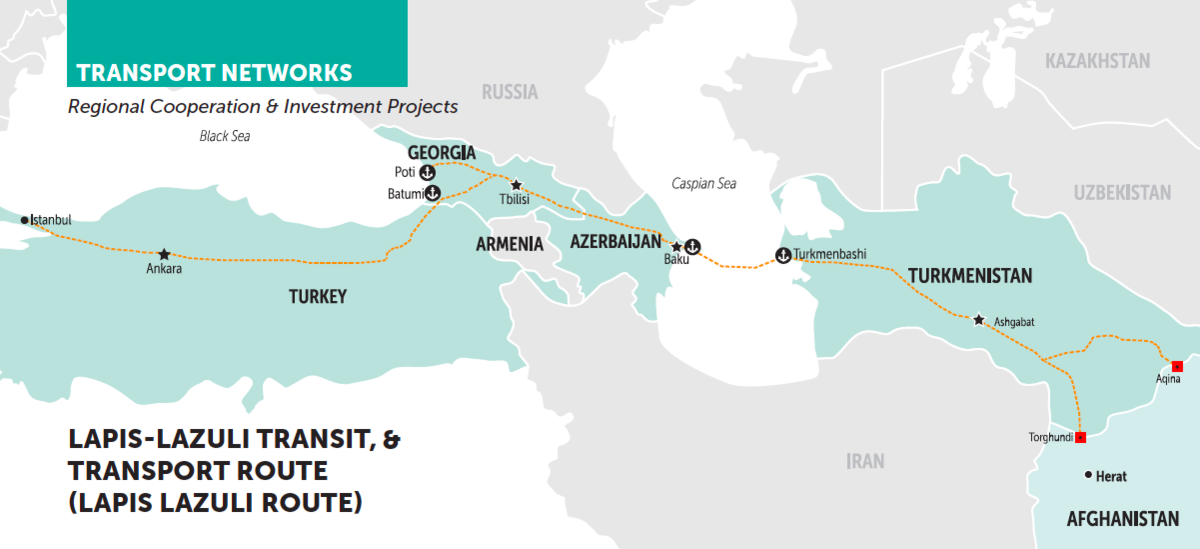
Azerbaijan, Afghanistan and Turkmenistan Sign Trilateral Roadmap for Cooperation on Eurasian Connectivity
Publication: Eurasia Daily Monitor Volume: 18 Issue: 23
By:

Leaders of an inter-departmental working group from Turkmenistan, Azerbaijan and Afghanistan agreed on a tripartite roadmap for deeper cooperation on the Lapis Lazuli Corridor, on January 16, 2021 (Mfa.gov.tm, January 16). The online meeting was attended by the deputy chairperson of the Cabinet of Ministers of Turkmenistan in charge of the transport and communications sector, Bayramgeldi Ovezov; Azerbaijani Deputy Prime Minister Shahin Mustafayev; and the acting chair of the Central Bank of Afghanistan, Ajmal Ahmadi. Addressing his colleagues, Mustafayev noted that on the basis of the initiative put forward by Azerbaijani President Ilham Aliyev on July 2, 2020, Baku had prepared the Roadmap to expand and deepen cooperation between the three participating countries in multiple directions (Trend.az, January 19). Reportedly, the Roadmap will expand trilateral partnership in a number of significant areas, such as IT, energy, telecommunications, transport, logistics, trade and investment. The signed document pays special attention to the issues of deepening border and customs coordination, with an eye to help remove barriers to the transportation of goods along the Lapis Lazuli Corridor (Kaspiyskiy Vestnik, January 26).
The multimodal, east–west Lapis Lazuli corridor, which originates in Afghanistan, is composed of overland routes that pass through Turkmenistan, followed by ferry connections across the Caspian to Azerbaijan; from there, goods continue by rail to Georgia, Turkey and potentially on to Europe. Conception of the project dates back to 2012. For a long time, the route was impassable due to insufficient infrastructure and economic and political instability in the member countries. However, the final agreement was signed on November 15, 2017 (Tolonews.com, November 15, 2017). The opening ceremony of the corridor took place on December 13, 2018 (Ariananews.af, December 13, 2018). Yet the shipment of goods along the Lapis Lazuli Corridor was carried out only sporadically in 2019.

A video summit of the three participating countries’ presidents, held on July 2, 2020, gave significant impetus to intensifying the efforts to develop the Lapis Lazuli Corridor. The associated trilateral negotiations covered issues of practical implementation of the transport project, including facilitating customs procedures to ensure the unimpeded movement of traffic flow along the route (News.az, July 8, 2020).
Azerbaijan’s decision to participate in the Lapis Lazuli project is aligned with its proactive foreign policy to promote regional interconnectivity. Azerbaijan benefits from a strategic geopolitical position, which allows Baku to enhance the wider connectivity of the entire Eurasian space (see EDM, November 30, 2017). To become one of the largest transit hubs in the region, Azerbaijan is actively investing in the transport sector, including the modernization of railways as well as the development of port and airport infrastructure. According to data released by the Asian Development Bank (ADB), which supports six trans-regional multimodal corridor projects that pass through Azerbaijan, this combined ADB-backed investment is estimated at about $4.6 billion in total value in 2012–2021 (Adbh.org, accessed February 10, 2021). Azerbaijan itself invested around $1 billion to construct two essential components of the Lapis Lazuli project—the Baku International Sea Trade Port Complex (Alyat) and the Baku–Tbilisi–Kars (BTK) Railway, at a cost of $760 million and $770 million, respectively (Reconnectingasia.csis.org, accessed February 10).
The geo-economic importance of the Lapis Lazuli route for Afghanistan was repeatedly emphasized by President Ashraf Ghani. As a landlocked country, Afghanistan has historically relied mainly on Pakistan for its international trade (The Diplomat, December 22, 2017). But since the movement of goods through Pakistan has become hampered by aggravated relations between Kabul and Islamabad, the Lapis Lazuli Corridor has carried growing shares of supplies traveling to and from Afghanistan. Using the Lapis Lazuli route, cargo from Afghanistan arrives in Europe in 16 days, while it takes more than 20 days to reach Europe via the port of Karachi (Caspiannews.com, September 10, 2020). Consequently, trade turnover between Azerbaijan and Afghanistan increased by 50 percent in January–April 2019, year-on-year, after the Lapis Lazuli Corridor became fully operational in the last month of 2018 (Economy.gov.az, May 27, 2019).
Meanwhile, Turkmenistan, which heavily relies on hydrocarbon resources, is seeking to diversify its economy. Accordingly, the Lapis Lazuli Corridor agreement corresponds to the country’s strategic priorities. Notably, Turkmenistan funded the construction of the southern terminus of the Akina–Andkhoy railway on Afghan territory (Tdh.gov.tm, January 14, 2021). Regarding this, Azerbaijan’s President Aliyev, speaking to his Turkmenistani counterpart, Gurbanguly Berdimuhamedov, declared, “I am also aware of your [Turkmenistan’s] investment policy in neighboring countries. Without this, it would be impossible to implement the Lapis-Lazuli project today.” Moreover, in late 2018, Ashgabat signed an agreement with Baku that allows for the exchange of preliminary information on cross-border cargo transport (President.az, November 22, 2018).
The Lapis-Lazuli Corridor is a crucial strategic transit project for central Eurasia. First of all, for all of the participating countries, this project offers the opportunity to integrate their infrastructure and economies into the wider east-west Eurasian overland (road and rail) transport corridors linking the economic powerhouses of Europe and East Asia. Relatedly, the Corridor promises to strengthen regional cooperation and boost mutual economic and cultural ties among Azerbaijan, Turkmenistan and Afghanistan, thus bestowing dividends to each country in the form of increased mutual trade and investment. Growing regional integration and access to the European Union’s large market may offer the most promising opportunity for these Eurasian neighbors to secure their economic future. In turn, this will balance or possibly even decrease the expanding economic presence of China in the region. From a geopolitical point of view, the route is mainly meant for trade: its overland capacity for the transit of military supplies and personnel is constrained by Turkmenistan’s neutrality (War on the Rocks, July 11, 2017). Despite this, the project is in line with the strategic interests of the United States and its Western allies as the route bypasses their three largest regional adversaries/rivals—Russia, China and Iran—and connects the landlocked region to Europe. It is not a coincidence that the signing of the trilateral roadmap for cooperation on the Lapis Lazuli Corridor this past January occurred only a few days after the visit to the region of the US special representative for Afghanistan reconciliation, Ambassador Zalmay Khalilzad. During his trip, Khalilzad pointedly encouraged the preexisting projects and plans for expanded regional connectivity, trade and development, which, he argued, can bolster and help sustain an Afghan peace agreement (Af.usembassy.gov, January 5, 2021).



